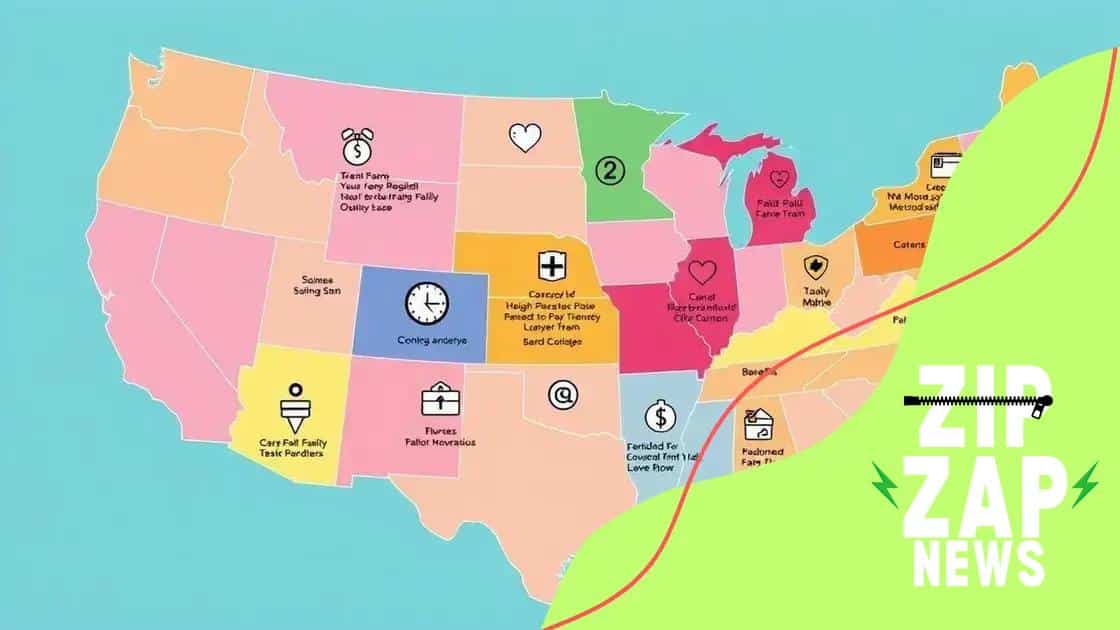Paid family leave policy updates for 2025: what you need to know

Paid family leave is a policy enabling employees to take paid time off for family care needs, with eligibility and duration varying by state regulations.
Paid family leave policy updates for 2025 are coming soon, and these changes could affect many households. Have you considered how this might make a difference in your life and family care plans? Let’s dive in.
Overview of paid family leave policies
Understanding paid family leave policies is essential as they provide crucial support for families during significant life events. These policies ensure that workers can take time off without the constant worry of losing their income.
What Are Paid Family Leave Policies?
Paid family leave refers to a program that allows employees to take time off to care for family members or themselves while still receiving payment. The specific regulations can vary widely by state or company policy. This flexibility helps maintain a healthy work-life balance.
Key Features of Paid Family Leave
- Duration: Policies typically allow for several weeks to months of paid leave.
- Eligibility: Criteria can include the length of employment and reasons for leave.
- Funding: These programs can be funded through employee contributions, employer contributions, or a combination of both.
- Job Protection: Employees are often guaranteed job security during their leave period.
With the push for more inclusive policies, many states are now implementing paid family leave programs tailored to meet the needs of their workforce. Such initiatives help reduce the stress associated with family responsibilities. Having the assurance of paid time off promotes not only individual well-being but also workplace productivity.
It’s important to call attention to the differences in policies across various states. For instance, some states provide more generous leave than others. Understanding these distinctions is key for both employees and employers to navigate the evolving landscape of paid family leave.
Impact on Families and Businesses
By allowing parents and caregivers to take time off for family needs, paid family leave positively influences family dynamics. It encourages bonding time with newborns, aids in recovery for serious illness, and supports caregivers. Businesses, in turn, may observe improved employee morale and retention.
Key changes in 2025 regulations
Significant changes to paid family leave regulations are expected in 2025, and employers and employees alike need to be informed. Understanding these updates will help everyone prepare for the impacts on work and family life.
What Are the New Regulations?
The upcoming regulations will expand coverage and benefits for many workers. More employees will be eligible, and the duration of paid leave is likely to increase. The goal is to make family leave accessible to a wider range of workers.
Increased Eligibility Criteria
- Broader Definitions: More family situations will qualify for leave.
- Extended Coverage: Part-time workers and freelancers may also gain access.
- Job Security: Enhanced protections against job loss during leave periods.
These reforms aim to provide better support for workers, allowing them to take necessary time off without overwhelming financial worry. Families should see a positive impact as the benefits of paid family leave become more widely available.
Duration of Leave
In 2025, employees may see an increase in the number of weeks they can take leave. This change recognizes the need for more time during critical family moments, such as welcoming a new child or caring for a sick relative. The added support helps maintain a healthy work-life balance.
Funding Changes
How programs are funded is also evolving. There might be options for both employees and employers to contribute, ensuring sustainability of the program. It’s essential for businesses to understand their roles and obligations under these revised regulations.
Finally, as organizations adapt to these new policies, training sessions may become essential for HR departments. They will need to understand the new landscape so they can best support their employees through these changes.
How states are approaching paid family leave

Different states are developing their own strategies for paid family leave, reflecting the diverse needs of their populations. Understanding how these approaches vary can help employees navigate their rights and options.
State-by-State Variations
Some states are leading the way in establishing comprehensive programs. For example, California and New York have set benchmarks for paid family leave by offering generous benefits and extended leave durations. These programs show a commitment to family-friendly policies.
Types of Programs
- Fully Funded Programs: Some states fund these programs entirely through payroll taxes, ensuring that employees receive benefits without financial strain on employers.
- Employer Contributions: In certain states, employers also contribute, creating a shared responsibility for funding paid leave.
- Opt-In Programs: A few states offer voluntary programs where businesses can choose to participate, leading to less uniformity.
While some states have robust policies, others are still in the development stages. This means that eligibility, duration, and benefit amounts can differ significantly depending on where one lives. Employees should check their state’s specific regulations to understand their rights.
Employers’ Role
Employers play a critical role in adapting to these diverse state policies. They need to establish clear communication about what is available to employees. Training HR personnel on these new laws is essential to ensure compliant and supportive environments.
Future Trends
As more states recognize the importance of paid family leave, we may see a trend toward more comprehensive and standardized policies across the country. Advocacy groups are pushing for change, which could lead to unified federal regulations.
Impact on employers and employees
The impact of paid family leave on employers and employees is significant and multifaceted. Understanding these effects can help both parties navigate this evolving landscape effectively.
Benefits for Employees
For employees, the availability of paid family leave means greater job security during critical life events. When workers know they can take time off without losing income, they experience less stress and increased peace of mind. This support can lead to better mental health and overall well-being.
Employer Advantages
- Increased Retention: Offering paid family leave can lead to higher employee satisfaction and loyalty. When employees feel supported, they are less likely to leave their jobs.
- Enhanced Reputation: Companies that provide paid family leave often gain a positive public image, attracting talent seeking family-friendly workplaces.
- Productivity Boost: Employees who return from leave feel more refreshed and focused, potentially increasing overall productivity.
However, the introduction of these policies can bring about challenges for employers. Companies may need to invest in training for HR staff to handle the complexities of compliance and employee relations related to leave. Additionally, they might have to adjust staffing models to accommodate periods of absence.
Financial Considerations
While providing paid family leave can incur upfront costs for employers, many find that the long-term benefits outweigh these expenses. It is essential for businesses to analyze the local laws and projected costs to ensure the sustainability of the paid family leave program.
In conclusion, both employers and employees need to understand the potential impacts of paid family leave to navigate this evolving system effectively. By fostering open communication and continuous education, they can work together to create a supportive work environment that benefits everyone.
Resources for understanding your rights
Knowing your rights regarding paid family leave is essential for navigating your options effectively. There are various resources available to help employees understand their entitlements and benefits.
Government Websites
Start with official government websites that provide up-to-date information on family leave policies. These sites often detail eligibility criteria, the duration of leave, and the application process.
Legal Aid Organizations
- Local Departments: Many states have labor departments that offer resources and assistance related to paid family leave.
- Non-Profit Groups: Organizations focused on workers’ rights often provide free legal advice and information on how to claim benefits.
- Community Workshops: Attend workshops or seminars offered by legal aid organizations to learn about your rights and the intricacies of paid family leave.
Another excellent resource is online forums where employees share their experiences and tips. These platforms can provide firsthand insights into navigating family leave policies.
Employee Handbooks
Employers should also provide clear guidelines in their employee handbooks. These documents typically explain the specific policies in place, detailing how paid family leave works within the company context.
Consulting HR Departments
Don’t hesitate to consult your human resources department for clarifications about your rights. They are the best point of contact for understanding the specific policies that your employer has in place.
Staying informed about your rights ensures that you are prepared to take necessary family leave when required. Empower yourself with knowledge to make the most out of the available resources regarding paid family leave.
FAQ – Frequently Asked Questions about Paid Family Leave
What is paid family leave?
Paid family leave is a policy that allows employees to take time off with pay to care for family members or themselves during significant life events.
Who is eligible for paid family leave?
Eligibility varies by state but generally includes full-time employees who have worked for a certain period and meet specific criteria.
How long can I take paid family leave?
The duration of paid family leave can vary widely depending on state laws, with some states offering several weeks to a few months of leave.
How is paid family leave funded?
Paid family leave can be funded through employee payroll taxes, employer contributions, or a mix of both, depending on the state or company policy.





